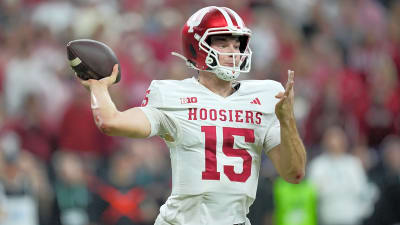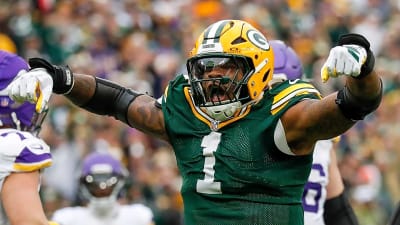- Home
- Quizzes
- My Quiz Activity
- Newsletters
- MY FAVORITES
- Add Sports/Teams
- SPORTS
-
NFL
- NFL Home
- Arizona Cardinals
- Atlanta Falcons
- Baltimore Ravens
- Buffalo Bills
- Carolina Panthers
- Chicago Bears
- Cincinnati Bengals
- Cleveland Browns
- Dallas Cowboys
- Denver Broncos
- Detroit Lions
- Green Bay Packers
- Houston Texans
- Indianapolis Colts
- Jacksonville Jaguars
- Kansas City Chiefs
- Las Vegas Raiders
- Los Angeles Chargers
- Los Angeles Rams
- Miami Dolphins
- Minnesota Vikings
- New England Patriots
- New Orleans Saints
- New York Jets
- New York Giants
- Philadelphia Eagles
- Pittsburgh Steelers
- San Francisco 49ers
- Seattle Seahawks
- Tampa Bay Buccaneers
- Tennessee Titans
- Washington Commanders
-
MLB
- MLB Home
- Athletics
- Arizona Diamondbacks
- Atlanta Braves
- Baltimore Orioles
- Boston Red Sox
- Chicago White Sox
- Chicago Cubs
- Cincinnati Reds
- Cleveland Guardians
- Colorado Rockies
- Detroit Tigers
- Houston Astros
- Kansas City Royals
- Los Angeles Angels
- Los Angeles Dodgers
- Miami Marlins
- Milwaukee Brewers
- Minnesota Twins
- New York Yankees
- New York Mets
- Philadelphia Phillies
- Pittsburgh Pirates
- San Diego Padres
- San Francisco Giants
- Seattle Mariners
- St. Louis Cardinals
- Tampa Bay Rays
- Texas Rangers
- Toronto Blue Jays
- Washington Nationals
-
NBA
- NBA Home
- Atlanta Hawks
- Boston Celtics
- Brooklyn Nets
- Charlotte Hornets
- Chicago Bulls
- Cleveland Cavaliers
- Dallas Mavericks
- Denver Nuggets
- Detroit Pistons
- Golden State Warriors
- Houston Rockets
- Indiana Pacers
- Los Angeles Clippers
- Los Angeles Lakers
- Memphis Grizzlies
- Miami Heat
- Milwaukee Bucks
- Minnesota Timberwolves
- New Orleans Pelicans
- New York Knicks
- Oklahoma City Thunder
- Orlando Magic
- Philadelphia 76ers
- Phoenix Suns
- Portland Trail Blazers
- Sacramento Kings
- San Antonio Spurs
- Toronto Raptors
- Utah Jazz
- Washington Wizards
-
NHL
- NHL Home
- Anaheim Ducks
- Boston Bruins
- Buffalo Sabres
- Calgary Flames
- Carolina Hurricanes
- Chicago Blackhawks
- Colorado Avalanche
- Columbus Blue Jackets
- Dallas Stars
- Detroit Red Wings
- Edmonton Oilers
- Florida Panthers
- Los Angeles Kings
- Minnesota Wild
- Montreal Canadiens
- Nashville Predators
- New Jersey Devils
- New York Islanders
- New York Rangers
- Ottawa Senators
- Philadelphia Flyers
- Pittsburgh Penguins
- San Jose Sharks
- Seattle Kraken
- St. Louis Blues
- Tampa Bay Lightning
- Toronto Maple Leafs
- Utah Mammoth
- Vancouver Canucks
- Vegas Golden Knights
- Washington Capitals
- Winnipeg Jets
- NCAAF
- NCAAM
- Olympics
- Boxing
- Entertainment
- Lifestyle
- Golf
- MMA
- Soccer
- Tennis
- Wrestling
- Sports Betting
- More Sports
- RESOURCES
- My Account
- YB on Facebook
- YB on Twitter
- YB on Flipboard
- Contact Us
- Privacy Policy
- Terms of Service
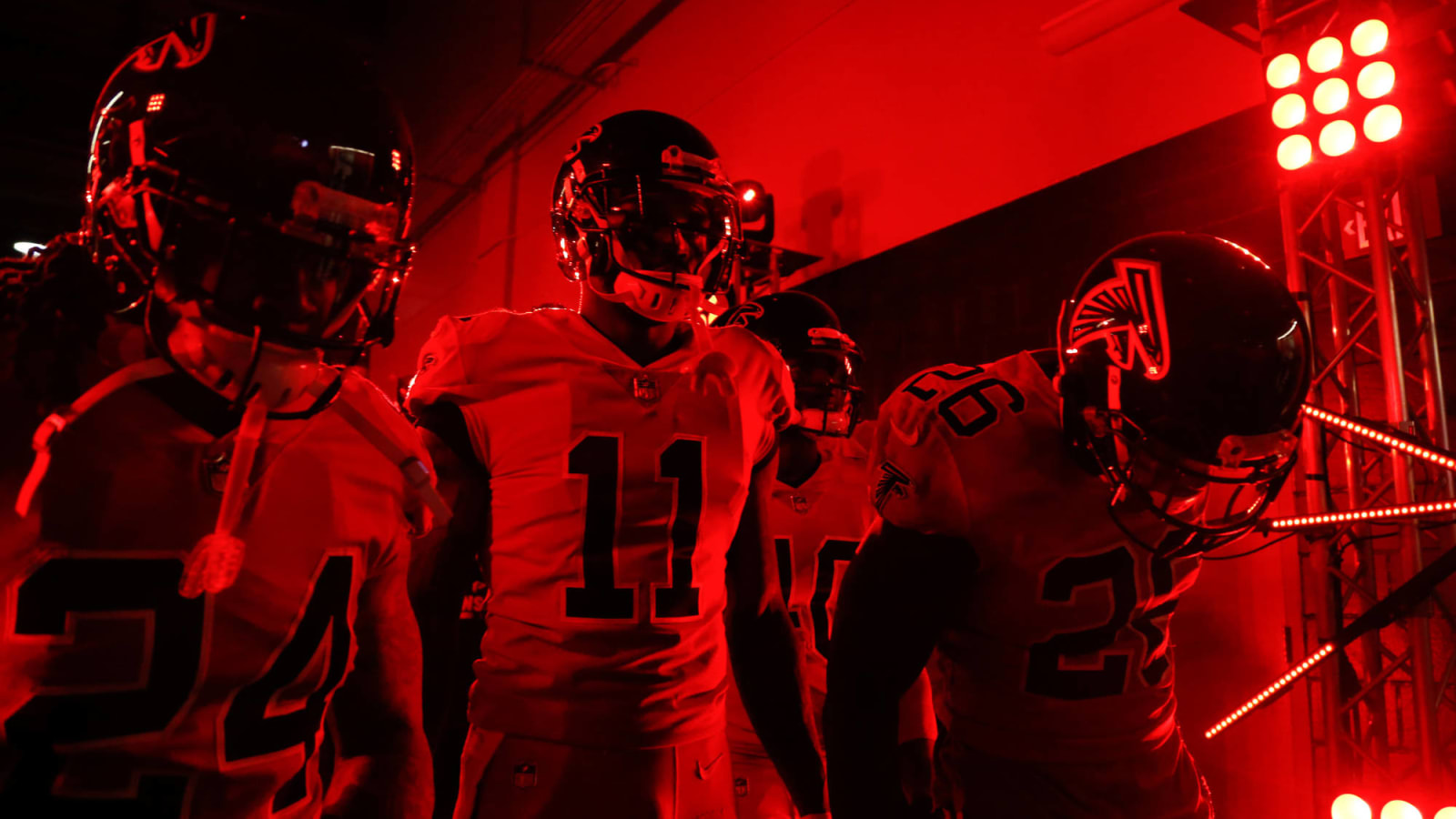
Every NFL team's biggest strength and weakness
As the league's 32 teams assess their rosters during the preseason slate, here's every team's best facet as well as each franchise's signature concern.
Arizona Cardinals strength: Fitz and David
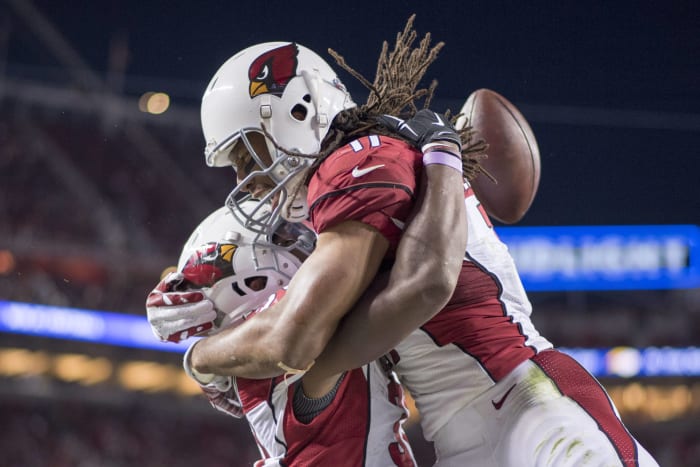
Atop their skill-position hierarchy, the Cardinals boast one of the NFL's best running backs and an all-time wide receiver great. Arizona hasn't sorted out David Johnson and Larry Fitzgerald's supporting cast yet, but this is an excellent place to start. Johnson's 879 receiving yards in 2016 suggests he'll take care of some Fitz complementary work this season, and the latter continues to enjoy one of the strongest post-age-30 receiving runs in NFL history. These two will obviously be crucial to a new-look Cards quarterback depth chart.
Arizona Cardinals weakness: offensive line

Tasked with protecting the league's most injury-prone quarterback: an offensive line riddled with players coming off major maladies (as a result: one of the worst run-offense DVOAs ever). This could make for some dicey Sam Bradford pockets. D.J. Humphries has not justified his first-round draft slot, and Arizona's left tackle missed 11 games last year. Mike Iupati returns to anchor the Cardinals' interior line, but the former Pro Bowler missed 15 contests in 2017. Injuries have limited new addition Justin Pugh extensively over the past two years as well, and right tackle Andre Smith is past his prime.
Atlanta Falcons strength: skill positions

One of the NFC's many talented teams, the Falcons possess a host of chain-moving dynamos. They used a first-round pick on Calvin Ridley to join a corps that already employs Julio Jones, Devonta Freeman and Tevin Coleman. Mohamed Sanu, whose production went up (703 receiving yards, Falcons-high five touchdown grabs last season) despite the rocky Kyle Shanahan/Steve Sarkisian transition, is not bad as an auxiliary wideout either. And moving from Taylor Gabriel to Ridley could be an upgrade, even in Ridley's rookie year.
Atlanta Falcons weakness: play-calling

Shanahan's second and final Falcons offense scored 540 points — tied for seventh-most in NFL history. Sarkisian inherited basically the same group. The follow-up output: 353 points —15th in the league in 2017. This was almost a "Speed"-"Speed 2 "-level drop-off, with Atlanta missing its Keanu Reeves. The Jason Patric in this scenario is under immense pressure to help the Falcons rebound because this team doesn't have many weaknesses. Sarkisian's play-calling served as the obvious deficiency last season, and he's on thin ice entering Year 2.
Baltimore Ravens strength: secondary

In a year where teams mysteriously devalued the safety position, the Ravens boast one of the best duos after having paid up for Eric Weddle and Tony Jefferson. On the strength of Weddle's six interceptions, the Ravens led the NFL with 22 last year. Baltimore did this after losing top cornerback Jimmy Smith midseason. Smith is set to return for a defense that also has 2017 first-round corner Marlon Humphrey and veteran Brandon Carr. With Weddle, Carr and Smith over 30, the "old" label can apply to this group, but it should still be reliable in 2018.
Baltimore Ravens weakness: pass offense

Placed under a microscope after the Ravens' Lamar Jackson pick, Joe Flacco's enjoyed a better training camp. But he hasn't delivered on his incredible contract. Flacco's 43.0 Total QBR ranked 23rd last season, and his yards per game (196.3) plummeted by over 70 yards from 2016. Jackson profiles as a long-term project, which places the Ravens in a tough spot this season. Their new receiving corps will rely heavily on Willie Snead (92 air yards in 2017, though he was better the previous two years) and an injury-prone John Brown (career-low 299 yards last year).
Buffalo Bills strength: secondary

Despite trading their No. 10 overall pick to the Chiefs last year, the Bills ended up with a stellar cornerback talent at No. 28 in Tre'Davious White. The runner-up for Defensive Rookie of the Year intercepted four passes and looks entrenched for a long haul in Buffalo. Additionally, Buffalo's bargain-buy free agent safeties Micah Hyde and Jordan Poyer came out of nowhere to post strong seasons. Having signed veteran Vontae Davis, the Bills have a sneaky-good back-end quartet.
Buffalo Bills weakness: pass offense

Hopefully Bills fans sufficiently reveled in the joy of snapping a 17-year playoff drought because a follow-up may be difficult. Tyrod Taylor isn't a franchise-level quarterback, but he was a better option than what Buffalo's going with this season. AJ McCarron hasn't distanced himself from social media punching bag Nathan Peterman, and Josh Allen's elite arm strength may be a ways away from Sunday action. And the QBs don't have much to work with yet. The Kelvin Benjamin- and Zay Jones-fronted receiving corps struggled badly last year. They remain the likely starters.
Carolina Panthers strength: linebacker

Thomas Davis is one of the best players in Panthers history. When it's all done, Luke Kuechly might end up being the best. They've been a top-tier NFL tandem for six years, but as the 35-year-old Davis' career winds down, Kuechly has seen a new running mate potentially emerge. Shaq Thompson will work as a three-down linebacker with Kuechly while Davis is suspended, and the fourth-year player may well continue in that capacity soon after. Regardless of how the Panthers divvy the snaps, they have no issues at linebacker.
Carolina Panthers weakness: secondary

Carolina carried a middling pass defense last season, allowing 229.1 yards per game (17th). The Panthers also used a second-round pick on cornerback Donte Jackson. Still, this group has not fully recovered from Josh Norman's exit. Captain Munnerlyn still mans the slot, and this will be a key season in determining former second-round CB James Bradberry's career track. Vulnerability also exists at safety, where 37-year-old Mike Adams and the once-cut Da'Norris Searcy are projected starters.
Chicago Bears strength: running back

The 2017 Bears boasted one of the worst pass-catching corps in modern NFL history, and this led to an offseason overhaul. Those Bears, though, debuted an intriguing 1-2 backfield combo of Jordan Howard and Tarik Cohen. Howard's numbers dipped from his dynamic rookie season, with his yards per carry sinking from 5.2 to 4.1. But he's still entrenched as Chicago's starter. His diminutive counterpart may see his role become more interesting now that Matt Nagy and ex-Oregon coach Mark Helfrich are calling the shots.
Chicago Bears weakness: edge defender

For years, the Bears featured a deep nucleus of outside linebackers, with Pernell McPhee, Lamarr Houston and Willie Young leading Chicago's edge contingent. Now Leonard Floyd has to show he was worth a top-10 pick. He's struggled to stay healthy, and the Bears' sneaky-decent defense does not have much else at this ever-important position. Depth piece Sam Acho returns, and defensive coordinator Vic Fangio brought in an inconsistent rusher from his 49ers days (Aaron Lynch). A lot rides on Floyd putting it together.
Cincinnati Bengals strength: defensive line

While Cincy's strength could just read "employs A.J. Green," the Bengals' defensive line has a balanced array of weapons. Carlos Dunlap and Geno Atkins rank first and second, respectively, in all-time Bengals sacks. They continue to spearhead Cincinnati's defense, though each one's contract expires after 2018. The Bengals also have longtime defensive end Michael Johnson in the fold, and the team looks to have hit on 2017 third- and fourth-rounders — Jordan Willis and Carl Lawson. The latter registered 8.5 sacks as a rookie.
Cincinnati Bengals weakness: Mike Brown
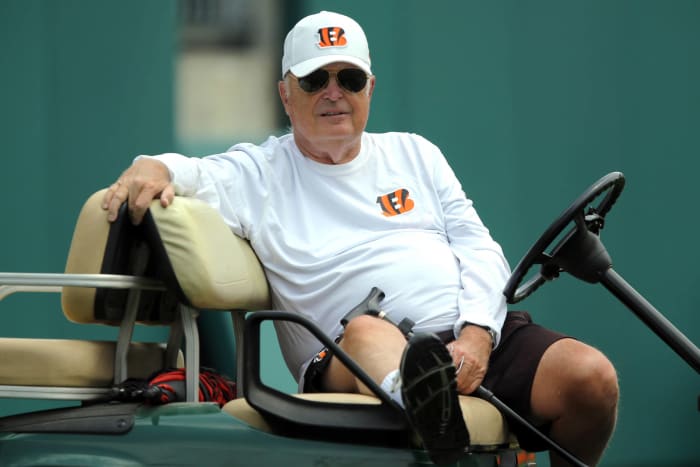
Jerry Jones has three Super Bowl titles to fall back on when critics point out his failures wearing both the Cowboys' owner and general manager hats the past 20-plus years. Mike Brown doesn't. The Bengals haven't been in Super Bowl contention much during the 83-year-old decision-maker's tenure. This franchise takes repeated chances on players with on- and off-field character issues — this proved costly the last time Cincinnati made the playoffs — and just signed Marvin Lewis to another extension. It's difficult to get a read on this franchise's dedication to contention.
Cleveland Browns strength: linebacker

Few defenses can match the Browns' second-level depth. In an era when teams mostly deploy two linebackers, Cleveland's stockpiled a quality quartet — enough so a Super Bowl starter (Mychal Kendricks) may be a backup. Jamie Collins, Christian Kirksey and 2017 breakout middle 'backer Joe Schobert anchor the Browns' defense. Given general manager John Dorsey's actions regarding some of predecessor Sashi Brown's investments, it wouldn't surprise if the Browns deal from this position of strength in the coming weeks.
Cleveland Browns weakness: head coach

Hue Jackson's 1-31 stretch established an NFL futility standard. While he was a coveted commodity on the 2016 coaching market and took a perpetually bad job at the worst possible time, he hasn't instilled much he's the man to turn this around. Likely needing at least six or seven wins to save his job, Jackson has not shown much in the way of leadership (at least, it hasn't translated yet) to suggest he'll be the coach when/if the Browns right this ship.
Dallas Cowboys strength: employing All-Pro offensive linemen

La'el Collins hasn't shown himself to be a reliable right tackle yet, and converted tackle Connor Williams' left guard capabilities aren't really known since he's yet to play an NFL down. But the Cowboys have Tyron Smith, Zack Martin and Travis Frederick. That's 13 combined Pro Bowls and five All-Pro honors. This trio anchors the Dallas offense. Smith, Martin and Frederick are each 27. The Cowboys have formed an unbelievable O-line core.
Dallas Cowboys weakness: pass-catchers

Jerry and Stephen Jones are trying something interesting this year in equipping a former fourth-round quarterback with the worst pass-catching corps in the NFL. Jason Witten and Dez Bryant were past their primes, but the Cowboys replaced them with an auxiliary Jaguars wideout (Allen Hurns) and, well, I'm not sure what exactly is going on at tight end. Hurns and a slot target (Cole Beasley) coming off a down season are Dallas' top receivers, though third-rounder Michael Gallup's impressed at camp. This could be a major impediment to a playoff run in a loaded NFC.
Denver Broncos strength: pass defense

Although they fell off their historic perch of 2015-16, the Broncos still thwarted passing attacks well last season. They ranked fourth in total defense. Von Miller led the NFL with 84 quarterback pressures in 2017 and now has a better supporting cast, with Bradley Chubb now in Denver. Aqib Talib is gone, but the versatile Chris Harris — who joined Talib as a 2016 All-Pro — has been a top-tier cornerback for six years. Bradley Roby and the rest of the secondary will be challenged without Talib, but aerial deterrence remains Denver's best facet.
Denver Broncos weakness: tight end

Other than Owen Daniels' two-touchdown showing in the 2015 AFC title game, Broncos tight ends have been largely MIA since injuries threw Julius Thomas off a historic touchdown pace in 2014. The team did not address the tight end spot this offseason, and underwhelming fourth-year man Jeff Heuerman (283 career receiving yards) is listed as the starter. One-time top prospect Jake Butt will be counted on to be a factor after his de facto redshirt season, but if that doesn't pan out, Denver is incredibly vulnerable here.
Detroit Lions strength: wide receiver

The Lions featured the only receiving tandem to surpass 1,000 yards in 2017, with Marvin Jones posting a 1,101-yard season (NFL-high 18 yards per catch) and Golden Tate going for 1,003. Injury trouble limited Kenny Golladay from performing his No. 3 receiver duties for part of his rookie season, but the third-rounder displayed intermittent promise. Detroit didn't make any additions to its receiving corps this offseason, and Tate is entering a contract year. But for 2018, the Lions boast one of the NFL's best receiving stables.
Detroit Lions weakness: tight end

Not that Eric Ebron delivered on expectations most Lions backers had when he became a top-10 pick, but he did provide Matthew Stafford with a viable weapon. It's unclear if any current Lions tight end will do that. Detroit returns 2017 fourth-rounder Michael Roberts (four career catches) and added Luke Willson and Levine Toilolo as free agents. Neither has surpassed 375 yards in a season. While receiving isn't the only part of this position's job description, the Lions' group is light on that part of it.
Green Bay Packers strength: quarterback

Aaron Rodgers has been the NFL's best quarterback for some time. His work for an overmatched Packers team in 2016 should have illustrated this. The NFL's all-time passer rating king wants to play until he's 40. While that should be comforting to Packer fans, the organization has squandered some of its 34-year-old QB's best years by refusing to use free agency as a consistent roster-building tool. Rodgers' collarbone trouble has now become a full-blown issue as well, but when he's healthy, the Packers have an unmatched advantage.
Green Bay Packers weakness: pass defense

The Packers did plenty in an attempt to fix this. They fired longtime defensive coordinator Dom Capers and brought in Mike Pettine. They devoted their top draft resources to addressing this concern, in selecting Jaire Alexander and Josh Jackson this year. But it's hard to know how useful this young secondary will be after two years of shaky play. Clay Matthews is in decline, and Nick Perry's 11-sack contract year in 2016 is starting to look like an outlier. Green Bay's window is now, and it's uncertain how ready its second-most important facet is.
Houston Texans strength: front seven
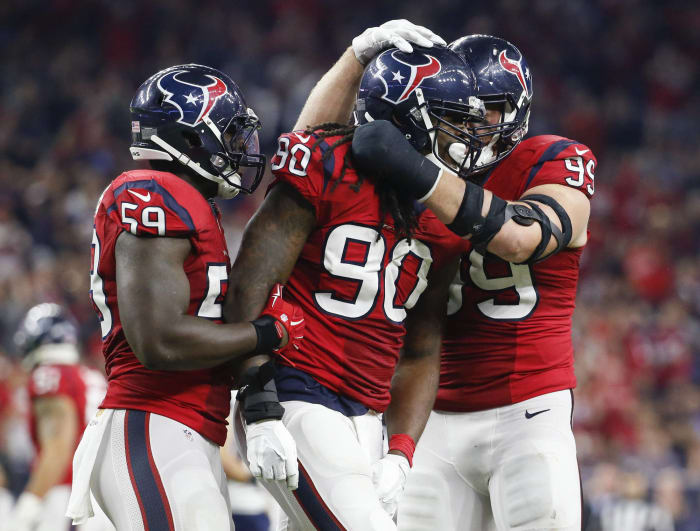
The Texans have not enjoyed much of an opportunity to pair their two superstar defenders together, at least not in peak form. Jadeveon Clowney wasn't ready yet when J.J. Watt was rampaging through the mid-2010s, and Watt is now coming off a second severe injury. But for now, the Texans have both on track for Week 1. Maybe it's not too late for this duo. Nice sidekicks are in place, too, in Whitney Mercilus (19.5 sacks from 2015-16) and recently extended inside linebacker Benardrick McKinney. Brian Cushing's replacement, Zach Cunningham, showed promise as a rookie as well.
Houston Texans weakness: offensive line

Set to redeploy Deshaun Watson after a season-ending injury, the Texans made a concerted effort to retool up front this offseason. They brought in three free agents to start. But Zach Fulton, Senio Kelemete and Seantrel Henderson may not be quality starters. Fulton reminds of recent Texans castoff Jeff Allen, who parlayed a strong Chiefs contract year into a well-paid Texans gig. Henderson has started one game the past two seasons, and Kelemete — a seventh-year veteran — has mostly been a backup. Center Nick Martin anchors the unit but is coming off his second significant injury in three NFL seasons.
Indianapolis Colts strength: quarterback

The Colts have experienced two abjectly bad seasons in the past 19 years. Both came because of career-threatening injuries to their starting quarterbacks. Andrew Luck's return raises the floor for this team considerably. Even playing hurt in 2016, Luck threw 31 touchdown passes and ended the year with a 96.4 QB rating — .01 off his best mark. Indianapolis is not expected to contend but has a surefire franchise quarterback. That provides optimism many teams cannot entertain. Plus, Jacoby Brissett is now a high-end backup, even if the Brissett-led Colts are a less capable operation.
Indianapolis Colts weakness: defensive personnel

There doesn't appear to be a position on this defense that can be considered reliable. Safety Malik Hooker showing no ill-effects after knee surgery would qualify, but everywhere else: uncertainty. Indianapolis finished with the 30th-ranked defense last season, and free agency centered around defensive lineman Denico Autry and linebacker Najee Goode. The Colts selected three front-seven options in the second round, and the status quo might not present much resistance against these rookies' efforts to commandeer starting jobs.
Jacksonville Jaguars strength: pass defense

The Jaguars yielded the fewest passing yards, more than 22 fewer than the next-best team, and held quarterbacks to the lowest passer rating last season. Free agent signings Malik Jackson, Calais Campbell and A.J. Bouye were each Pro Bowl honorees, and homegrown starters Jalen Ramsey and Yannick Ngakoue showed they could be long-term Jacksonville residents. The Jags still have Dante Fowler and Marcell Dareus and added defensive tackle Taven Bryan in Round 1. This is an absolutely stacked array of talent.
Jacksonville Jaguars weakness: quarterback

Instead of attempting to upgrade at sports' premier job, either through free agency or the draft, the Jaguars stood pat. Blake Bortles will continue to lead a team that now has Super Bowl aspirations. Although he underwent wrist surgery in January and said he's pain-free after two years of issues, this is a massive risk. Bortles did throw 35 touchdown passes in 2015, but the Jags still went 5-11 that year. Entrusting this lethal defense's capabilities to Bortles — likely for the next two seasons, since the Jags passed on relevant rookie talent — could restrict an otherwise loaded team.
Kansas City Chiefs strength: skill positions

Kareem Hunt, Travis Kelce, Tyreek Hill and Sammy Watkins represent as good of a weaponry consolidation as any team possesses. Patrick Mahomes holds the keys to the Chiefs' contention chances after years of high-floor Alex Smith play, but he has plenty of help. Hill may be the NFL's fastest player and topped 1,100 air yards last season. Kelce remains the league's second-best tight end. Watkins averaged 15 yards per catch in each of his first four seasons. Meanwhile, Hunt continues Kansas City's storied succession of running backs, taking the baton from Priest Holmes, Larry Johnson and Jamaal Charles.
Kansas City Chiefs weakness: cornerback

New Chiefs general manager Brett Veach authorized a $16 million-per-year contract for Watkins, likely their offense's No. 4 option. This came after the Chiefs essentially told a player with a best-cornerback-alive ceiling to seek his money elsewhere. Kansas City's defense ranked 31st in DVOA last season with Marcus Peters. But the All-Pro turnover machine is gone, and despite acquiring breakthrough slot corner Kendall Fuller in the Smith trade, the Chiefs don't have much around him. Unremarkable fourth-year man Steven Nelson and free agency flier David Amerson look like the Nos. 2 and 3 corners. That could pose a problem.
Los Angeles Chargers strength: pass defense
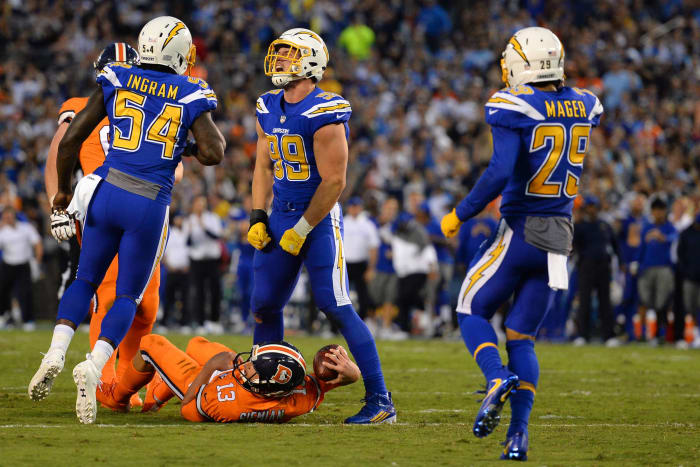
Joey Bosa and Melvin Ingram represent the best edge-rushing duo the NFL offers in 2018. They combined for 23 sacks to lead the league's No. 3 pass defense last season. Casey Hayward has 11 interceptions in two Chargers campaigns, and sidekicks Trevor Williams and Desmond King showed immense promise — each ranking as top-20 Pro Football Focus corners. The Bolts will soon unleash first-round pick Derwin James. Philip Rivers and this pass defense give the Chargers pole position in a division they haven't won since 2009.
Los Angeles Chargers weakness: run defense

The Bolts, however, trotted out the NFL's second-worst run defense last season, the unit bottoming out in a do-or-die game in Kansas City. Questions still loom across the non-Bosa/Ingram sectors of Los Angeles' front seven. Corey Liuget has not lived up to his contract and is suspended four games. Denzel Perryman is talented but has missed 13 games the past two years. L.A. used a second-round pick on a linebacker and a third-rounder on a defensive tackle, but this remains a problem area.
Los Angeles Rams weakness: edge defender

Amid the spree of impact additions and contract extensions, the Rams are thin at outside linebacker. They traded a trending-down Robert Quinn but have mostly unknown commodities at one of American sports' most important positions. This could work out due to Aaron Donald and Ndamukong Suh teaming up on the D-line, but it's curious. Former Division II standout Matt Longacre (5.5 sacks in 2017) leads an anonymous group of edges for a Super Bowl contender whose roster houses no outside 'backer drafted in the third round or higher.
Miami Dolphins strength: defensive end

Three Dolphins defensive ends will comprise more than a sixth of their salary cap, with Robert Quinn, Andre Branch and Cameron Wake set to earn just more than $30 million collectively. Miami has plenty of holes; D-end isn't one of them. Supplementing the veteran troika are 2017 first-rounder Charles Harris and Quinn's former Rams teammate William Hayes. At 36, Wake is still going strong. His 10.5 sacks led the Dolphins by six last year. A return to a 4-3 scheme could reignite Quinn, who hasn't come close to matching his 19-sack 2013 season.
Miami Dolphins weakness: quarterback uncertainty

In the final stages of surmounting a second severe knee injury, Ryan Tannehill enters a pivotal season. He set the Dolphins on a playoff course before the first of those setbacks occurred in December 2016 and hasn't played since. With well-regarded backup Matt Moore out of the picture, Brock Osweiler is Miami's QB2. And his camp work doesn't appear he's on the verge of a turnaround. The Dolphins can easily get out of Tannehill's contract in 2019, so if he falters, Miami could soon be scanning the college ranks for its next signal-caller.
Minnesota Vikings strength: defense

Minnesota led the NFL in total defense last season and ranked second against the pass and the run. The Vikings are set at almost every position, and they have a Super Bowl-caliber defense. They added Sheldon Richardson up front and extended middle linebacker Eric Kendricks and young defensive end Danielle Hunter. Harrison Smith may be the best safety there is, and Xavier Rhodes is among the league's best corners. Minnesota doesn't have a proven player at weakside 'backer, but that's serious nitpicking.
Minnesota Vikings weakness: offensive line

Now with a fully guaranteed Kirk Cousins contract on the books to go along with numerous extensions over the past three years, the Vikings are as committed to their core performers as any team. But they're vulnerable up front. Pro Football Focus' No. 22 line from last season lost top blocker Joe Berger to retirement, lost guard starter Nick Easton for the season and has young center Pat Elflein finishing up a long rehab. Middling left tackle Riley Reiff is a slight step up from Matt Kalil, but Minnesota's right tackle job is unsettled.
New England Patriots strength: Belichick and Brady

It's arguable the Patriots have the best coach, quarterback and tight end in NFL history. Aside from when they spent January Sundays in Denver, the Pats are 8-0 in the AFC playoffs since 2013 despite having a twilight-years quarterback and an injury-prone tight end. Bill Belichick and Tom Brady are the greatest HC/QB tandem in NFL history, and Rob Gronkowski's dominance has helped make Brady's endless prime possible. New England lost key pieces this offseason, but that's not abnormal. Belichick continues to find ways to make this work.
New England Patriots weakness: era fatigue

This Pats roster does not look as strong as the 2014 or '16 Super Bowl champion outfits. New England's still the AFC favorite, but the end is near. The Belichick-Brady-Robert Kraft relationship has endured hiccups over the past several months, despite intermittent statements of public support. Brady is underpaid and stayed away from the team as long as possible this year. Belichick mysteriously traded a possible franchise QB for a second-round pick, and Gronkowski is justifiably upset about his contract. The system may be breaking down.
New Orleans Saints strength: quarterback

Although Mark Ingram and Alvin Kamara became the first running back teammates to eclipse 1,500 yards in a season, Drew Brees still drives this team. He recaptured the completion-percentage record (72 percent) and did it on 8.1 yards per attempt — his best figure since 2011. Brees has perhaps his best team since the 2009 Super Bowl outfit, but the Saints obviously fall apart without their future Hall of Famer. Brees took his foot off the gas pedal last year (Saints-years-low 23 TD passes), but he's about to surpass Peyton Manning's passing-yardage standard and looks to have more years left in the tank.
New Orleans Saints weakness: tight end

Thirty-eight-year-old Ben Watson along with Josh Hill (125 receiving yards last season) are positioned to handle tight end responsibilities for a Super Bowl contender. The Saints did not address this position beyond Watson this offseason and look to be severely limited here. Although the Saints haven't used their tight ends nearly to the degree they did when Jimmy Graham lived in Louisiana, Brees doesn't have much to work with here.
New York Giants strength: Beckham and Barkley

All due respect to Tiki Barber and Amani Toomer, the most talented running back and wide receiver in a near-100-year-old franchise's history likely reside on this roster. Odell Beckham Jr. has proved to be an unparalleled aerial force for a team that's mostly lacked them, and Saquon Barkley — while obviously needing to show he's worth the rare investment — brings supreme running back talent. The Giants are counting on Eli Manning to give them more quality years, and he'll need this flashy duo to make good on the organization's faith.
New York Giants weakness: cornerback

General manager Dave Gettleman spent big to address the Giants' beleaguered offensive line, but the new GM did little to repair a historically toxic cornerback situation. Janoris Jenkins, Eli Apple and the since-cut Dominique Rodgers-Cromartie were all given team-imposed suspensions last season. Big Blue did not draft a corner in April, and its third-round supplemental draft pick (Sam Beal) is out for the season. A year after coaches and teammate Landon Collins criticized the volatile Apple, he's expected to start. This arrangement looks a little shaky.
New York Jets strength: secondary

Jamal Adams and Marcus Maye each played over 1,000 snaps last season, gaining experience for future games that (hopefully for Jets fans) will be more important. Last year's first- and second-round picks are joined now by high-priced cornerback Trumaine Johnson, a seasoned veteran and only cornerback on the Forbes List. While Buster Skrine and Morris Claiborne don't make 2017 Bruce Springsteen-level money nor profile as long-term future Jets cogs, they give Gang Green a balanced top five in the secondary.
New York Jets weakness: edge rusher

The top 2017 Jets sacker who is still on the team? David Bass, a dominant Division II pass rusher but a player who's been mostly an NFL backup. He had 3.5. Gang Green's projected outside linebacker starters Jordan Jenkins and Josh Martin combined for 4.5. The Jets aren't expected to contend this season, with it profiling more as a Sam Darnold learning year. But this is a team that should be targeting Khalil Mack in a trade (if he's, in fact, available): one flush with cap space and in dire need of an impact edge player.
Oakland Raiders strength: interior offensive line

Potentially set to be flanked by Pro Bowl left tackle Donald Penn and first-rounder Kolton Miller, the Raiders' dominant interior-line trio enters a third season together. Left guard Kelechi Osemele and center Rodney Hudson are now two-time Pro Bowlers, and Gabe Jackson has been a reliable right guard. There's a reason Marshawn Lynch looked better with the 2017 Raiders (4.3 yards per carry) than he did with the 2015 Seahawks. These men had a key say in Beast Mode's resurgence.
Oakland Raiders weakness: Khalil Mack's sidekicks

Whereas general manager Reggie McKenzie erred in 2017 by devoting his free agency funds to an already-potent offense instead of a reeling defense, Jon Gruden threw money at numerous veterans. The Raiders have not had a defense that ranked in the top half of the NFL in eight years, and despite featuring Mack, Oakland's struggled defending aerial attacks. The Raiders were the first team in NFL history to go seven games without an interception, and they extended that streak to 10 contests last season. Work lies ahead for new DC Paul Guenther.
Philadelphia Eagles strength: defensive line
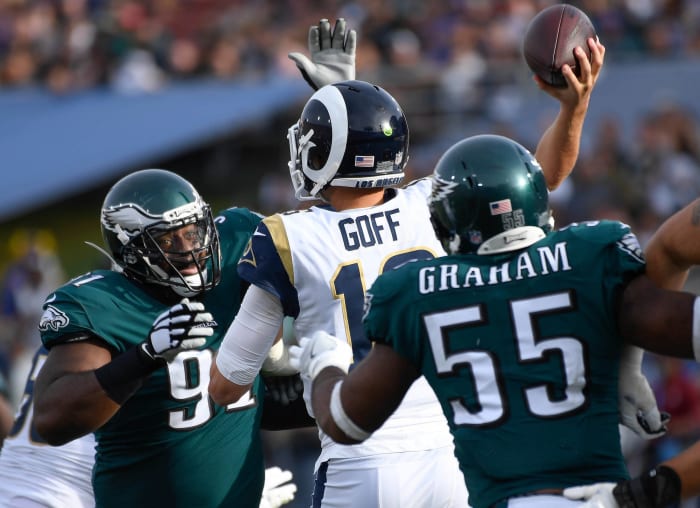
A strong case can be made the 2017 Eagles' defensive line was the best position group in football. The 2018 version has Michael Bennett and Haloti Ngata. This is an insane collection of talent. Fletcher Cox and Brandon Graham are two of the best at their respective positions, and Chris Long is an overqualified situational rusher. Breaker of Reggie White's Tennessee sack record, Derek Barnett showed promise as a rookie. And Philadelphia's Cox-Ngata-Timmy Jernigan setup should continue to produce elite run-stoppage work.
Philadelphia Eagles weakness: cornerback

The most consistent corner on the Super Bowl champion Eagles is now in New Orleans, and the holdovers comprise one of the few uncertainties on the defending champs' roster. Ronald Darby, Jalen Mills and a now-healthy Sidney Jones will be challenged. Tom Brady located numerous wide-open receivers in Super Bowl LII, and that was with Patrick Robinson on the Eagles, during a preposterous 505-yard passing night. While Philly can rely on its intergalactic defensive line depth chart, this defense's coverage acumen isn't known.
Pittsburgh Steelers strength: skill positions

No team can match the Steelers' one-two punch of Antonio Brown and Le'Veon Bell. These are Hall of Fame talents at the height of their powers. A Week 15 injury deprived Brown of a great shot at being the first wide receiver MVP; he still led the league with 1,533 air yards to continue an NFL-record stretch . Bell's negotiations have overshadowed his high-volume dominance, but he's a two-time All-Pro. This duo is a prime reason the Steelers continue to contend. JuJu Smith-Schuster is the latest in a long line of promising Pittsburgh WR2s.
Pittsburgh Steelers weakness: pass defense

Ryan Shazier's injury gutted the Steelers, who had a strong chance to dethrone the Patriots in 2017. Though they ranked fifth defensively, the Steelers struggled down the stretch and bottomed out in a disastrous divisional-round defeat. Pittsburgh signed Morgan Burnett to improve a shaky safety corps but still has questions there and at linebacker, where journeyman Jon Bostic and former seventh-rounder Tyler Matakevich are vying to replace Shazier. The team used a first-round pick on a project safety (Terrell Edmunds), but in a vital year for the franchise, potential leaks remain on defense.
San Francisco 49ers strength: it's early, but quarterback

Fifth-year veteran Jimmy Garoppolo has still thrown only 272 NFL passes. But it's hard to ignore the spark he provided for the 49ers. San Francisco went 2-14 in 2016 and started 1-10 last season. The 49ers now have the 12th-best odds to win Super Bowl LIII. Garoppolo led a young team to five straight wins to close out the season, leading the 49ers to victories over the playoff-bound Jaguars and Titans (and the Rams' reserves) in the process. After an offseason in Kyle Shanahan's system, expectations are high for Tom Brady's former backup.
San Francisco 49ers weakness: edge defender

The 49ers have expended immense draft capital to address their defensive line, using first-round picks from 2015-17 to fortify the unit. That hasn't manifested itself in the form of sacks yet. Among players who are set to be defensive ends on the 2018 49ers, Solomon Thomas was the only one to register at least three sacks last season. San Francisco has two starting ends, Thomas and Arik Armstead, who may be better as inside rushers. But DeForest Buckner will need better edge support if the 49ers' pass rush is to be effective.
Seattle Seahawks strength: linebacker

The last bastion of the Seahawks' NFC champion defenses, Bobby Wagner and K.J. Wright stick out on a rebuilding unit. Now a three-time All-Pro, Wagner may be the lone Super Bowl-era defender the team wants to keep around to mentor the next wave. Wright's contract is up after this season, and Earl Thomas has made his feelings about his Seattle status known. While the Seahawks look to have easily their worst team in the Russell Wilson era, they still employ Wagner, his trusty three-down sidekick and highly publicized rookie Shaquem Griffin.
Seattle Seahawks weakness: offensive line
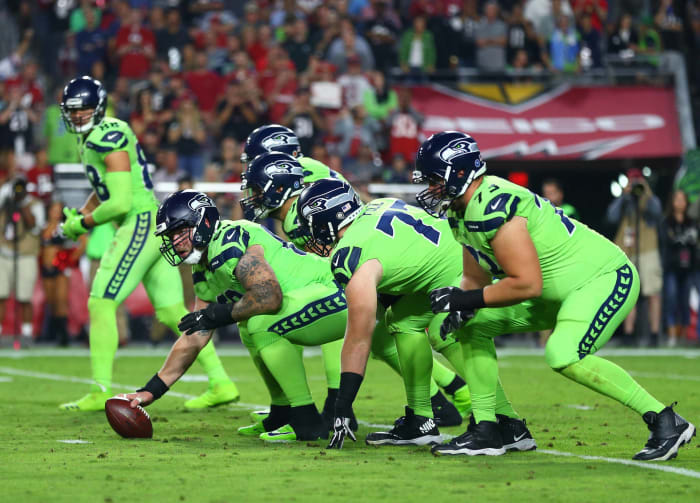
The runaway winner of this category the past few years, Seattle's O-line had some competition in 2018. Beyond the now-33-year-old Duane Brown, there isn't much to like about the Seahawks' front. Center Justin Britt is now at his third NFL position. Right tackle Germain Ifedi hasn't panned out. And Seattle — after the Luke Joeckel reclamation project bombed — added D.J. Fluker, an embattled ex-first-round tackle-turned-guard now on his third team in three years. It may still be tough going for Wilson and his running backs this season.
Tampa Bay Buccaneers strength: pass-catchers

Mike Evans is an established No. 1 wide receiver, and DeSean Jackson has been one of the best deep threats in NFL history. The Buccaneers look to have found a crucial piece in 2017 third-rounder Chris Godwin, who came on strong late last season and is drawing extensive praise this summer. Adam Humphries has posted back-to-back 600-plus-yard seasons and seems overqualified for a WR4 gig. Cameron Brate-O.J. Howard (1,023 yards, 12 touchdowns last year) also may be the top tight end tandem in the game.
Tampa Bay Buccaneers weakness: quarterback

They of the No. 32 pass defense last season, the Bucs may have less talent in the secondary. But Jameis Winston's on- and off-the-field issues take precedence due to the position's obvious importance. The 2015 No. 1 pick has yet to put it together, carrying his Florida State habits — interceptions, immaturity — to the pros. The Bucs picked up his fifth-year option but appear to be trying to distance themselves from him . Winston failing likely means Dirk Koetter and general manager Jason Licht will be out as well. A lot rides on the Bucs' starting QB this season.
Tennessee Titans strength: running game

Anchored by tackles Taylor Lewan and Jack Conklin, the Titans have assembled one of the league's better offensive lines. And they did well to bring in a running back through free agency who complements Derrick Henry. Dion Lewis' skill set differs greatly from DeMarco Murray's, and the new Tennessee tandem looks like one of the NFL's best backfields. The shiftier Lewis led all backs in 2017 Defense-adjusted Yards Above Replacement, and Henry has enjoyed managed workloads thanks to Murray's presence. This should be a dependable Titans facet.
Tennessee Titans weakness: coaching inexperience

Mike Vrabel was the Texans' defensive coordinator for one season. Injuries beset that defense, but Houston ranked 24th in total defense last season — down from first in a largely J.J. Watt-less 2016 under Romeo Crennel. Patriots South hired him nonetheless. New OC Matt LaFleur had good teachers, serving as QBs coach under Kyle Shanahan in Atlanta and OC-in-name-only under Sean McVay in L.A., but the 38-year-old assistant has never been a play-caller. This is a big step. Vrabel and LaFleur are now running a team coming off a playoff win, and the adjustments to the new roles may take time.
Washington strength: edge defender

Ryan Kerrigan doesn't receive much attention, but the eighth-year player's one of the most consistent edge rushers in the game. Only Von Miller, J.J. Watt and Cameron Wake have more sacks than Kerrigan's 71.5 since 2011. Preston Smith flanks him on the heels of his second eight-sack slate. Washington probably won't be getting Ravens-level Pernell McPhee due to his spate of injuries, but he played well when available last season. Second-round pick Tim Anderson (one of three Alabama cogs expected to start) rounds out a quietly good group.
Washington weakness: pass-catchers
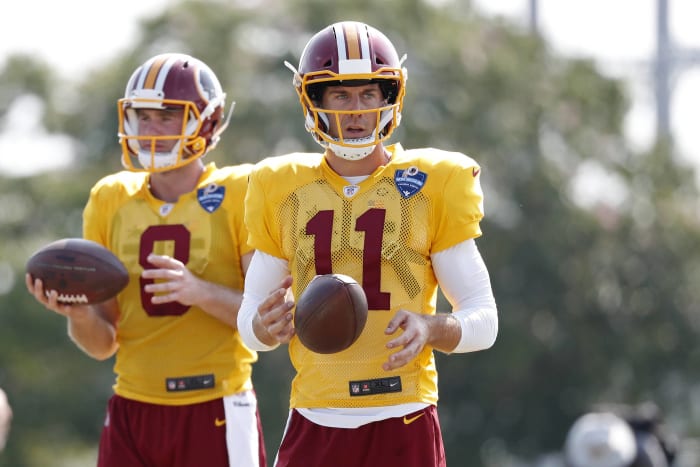
Ten-team fantasy league starting lineups may not feature any Dallas or Washington pass-catchers. As Patrick Mahomes now has a host of weapons in Kansas City, Alex Smith leaves to find little help in his new locale. Jordan Reed's one of the NFL's best tight ends, when healthy. He's missed 28 games in a five-year career. Deep threat Paul Richardson is in the nation's capital after an inconsistent run in Seattle. Slot man Jamison Crowder looks like the most reliable option here, with former first-rounder Josh Doctson having shown little early on.
Sam Robinson is a sportswriter from Kansas City, Missouri. He primarily covers the NFL for Yardbarker. Moving from wildly injury-prone sprinter in the aughts to reporter in the 2010s, Sam set up camp in three time zones covering everything from high school water polo to Division II national championship games
More must-reads:
- Best and worst moves of the NFL offseason
- Ten NFL veterans in danger of losing their starting jobs
- The 'WRs selected in the first round of the NFL Draft' quiz
Customize Your Newsletter
 +
+
Get the latest news and rumors, customized to your favorite sports and teams. Emailed daily. Always free!
PRIVACY POLICY EDITORIAL POLICY CONTACT US
ABOUT YARDBARKER TERMS OF SERVICE
Use of this website (including any and all parts and
components) constitutes your acceptance of these
Terms of Service and Privacy Policy.
This site is for entertainment purposes only.
There is no gambling offered on this site.
Gambling Problem? Call 1-800-Gambler.


